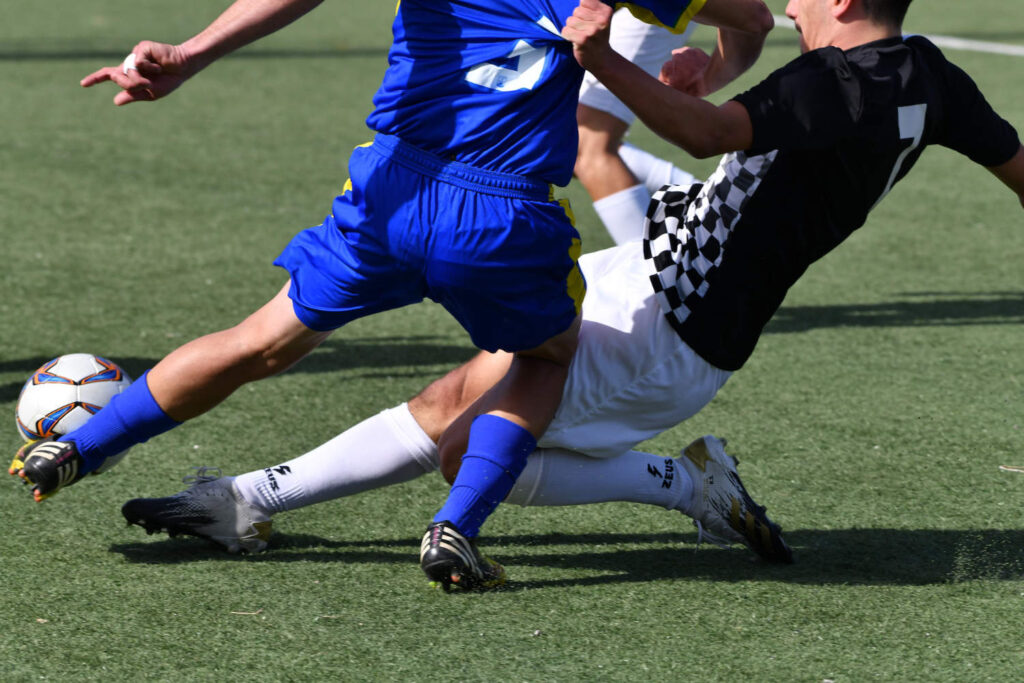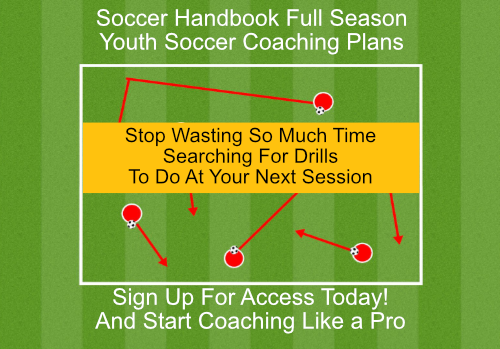One of the most important things a soccer team can have is a strong defense. After all, the fewer goals conceded, the easier it is to outscore the opponent and win the game. How a team uses their defensive positions is vital.
It goes with the adage:
“The Best Offense is a Great Defense.”
However, understanding defense in soccer can be complicated. There are many different ways defenders can be utilized, and there are different formations in which they can be used. Here’s what you need to know about the defense.
Want to learn about other roles on the pitch? Check out our article on soccer positions, their numbers, and roles!
Defensive Positions in Soccer

Soccer has four defensive positions: center back, right fullback, left fullback, and goalkeeper. Each of these positions has a vital role to play in the backline.
The left fullback positions themselves on the left side of the center backs. The right fullback positions themselves on the right side of the center backs. Both positions frequently advance up the field more than center backs, but they still have the responsibility to return and defend.
Center backs play in the center of the defense, rarely leaving the defensive half of the field. Usually, there are two center backs, one on the left and one on the right side of the defense. Some formations use three center backs. One person is in the middle, while the other two are slightly to the side as right and left center backs.
The goalkeeper is one of the most critical positions on the field. They are the only players who can use their hands and are tasked with keeping the ball out of the net at all costs.
Defensive Positions in Soccer
As soccer has evolved over time, so have the positions, particularly in defense. Fullbacks used to be essentially wide center backs, ensuring the offense couldn’t get past them on the outside. In the modern game, the role of fullbacks has completely changed. Today, we expect fullbacks to push forward and assist the attack out wide using the sides of the field.
Depending on the formation, the attacking roles of these fullbacks change, too. England’s Trent Alexander-Arnold, for instance, prefers to put crosses into the box for his attackers to put into the back of the net. Faster fullbacks, like Canada’s Alphonso Davies, carry the ball forward with speed, dribbling, and pushing higher up the field. However, they have to be sure to recover and defend as well.
Center backs have also seen their role change over time, but they still have the same main job: make sure no one gets past them. Center backs are expected to be the bravest players on the field, making sliding stops and aggressive tackles to prevent goals. As a result, center backs often are team captains.
They also have an important role on offense, even if they don’t push as high upfield as fullbacks do. Pushing high up the field puts more pressure on the opposing team, shortens the field, and makes it easier to keep the ball in the offensive end of the field.
Many professional teams focus on building play from the back — meaning that the goalkeeper and center backs start with the ball and need to create opportunities, usually with solid passing to distribute the ball. Some defenders can also bring the ball forward by dribbling before passing it to the attackers or midfielders.

Because goalkeepers can’t use their hands outside of the box, many of them don’t ever leave the box. However, there are some instances when it makes sense for them to do so. When a team is trying to keep possession, the goalkeeper can try to find open teammates to pass to.
Germany’s Manuel Neuer has revolutionized the goalkeeper’s position with his “sweeper keeper” mentality. He is known for his defense activities outside of the goalie box. He even sometimes tries to make slide tackles and win the ball back outside of the box, although it is risky because it leaves the net open.
Typical Soccer Formations
There are dozens of different formations that can be used in soccer, and how many defenders there are in soccer is constantly changing. However, for defenders, there are three different types of defense: a three-man defense, a four-man defense, and a five-man defense.
A three-man defense is a formation without fullbacks. Instead, there are three center-backs: one slightly on the left, one slightly on the right, and one in the center.
All of them tend to stay back, rarely pushing forward because, with just two other defenders, it can leave the defense exposed. There are no full-backs, although typically, these formations use a wide midfielder who can occasionally help on defense. Examples of a formation with a three-man defense include 3-5-2, 3-4-3, and 3-2-4-1.



A four-man defense is a traditional style, the most common type of formation in the game. As previously mentioned, it uses all of the main defensive positions in soccer: right and left fullbacks and two center backs. It is popular because it is arguably the safest defensive line to use since all zones of the field are covered, and there are well-positioned defenders to recover in case one defender gets beat. Formations with a four-man defense include 4-3-3, 4-4-2, or 4-2-3-1.



A five-man defense combines the ideas of a three-man defense and a four-man defense. It uses three center backs who play more or less the same way they would in a three-man backline.
The difference is that there are also right and left fullbacks, used to add an extra level of safety to the defense. They still push forward and help in attack, but these formations are seen as heavily defensive and are typically used by underdog teams looking to avoid defeat. This tactic is also often called “Parking the Bus” because so many players are defending behind the ball. Examples include 5-3-2, 5-4-2, or 5-2-2-1.



Tips for Defenders in Soccer
Here are some tips and tricks to be your best defender. Read more about goalkeeping tips here.
Be patient. Defenders need to wait until the timing is right to make a challenge.
If a defender rushes in and tries to win the ball too early, the attacker can easily get passed them. Rushing into a tackle can also make it difficult or impossible for a defender to recover if they are dribbled past. It’s essential to wait for the ideal opportunity to challenge and let the attacker make the first move.
Watch the ball, not the player. Everyone has seen stepovers and fancy dribbling from flashy attackers like Neymar Jr and Lionel Messi. They try a few moves, the defender is fooled, and the attacker runs right past them. As simple as it sounds, defenders must watch the ball, not the player — don’t get distracted by any tricks the attacker may try.
Try using your weak foot. Regardless of position, it’s important to avoid overreliance on one foot. However, that’s particularly important in defense, as defenders often (naturally) position their bodies based on which foot they are more comfortable with rather than reacting to what the attacker is doing. A defender who can use either foot can better adjust in one-vs-ones and is also better at playing the ball from the back.
Push the attacker to their weaker side. Just like defenders, attackers often rely on their dominant foot and try to put themselves into situations where they can use it, whether to shoot or cross. The best defenders adjust their bodies to force the forward to dribble onto their weaker side — often towards the sideline — where they have fewer options and may have to use their weak foot, neutralizing the threat. This also creates a poor angle for shooting on goal.
Anticipate their next move. Defenders need to be able to read the field and understand how a play will unfold or what an attacker will do. An attacker’s stance or even where they are looking can help a defender anticipate what he may do next, making it easier to decide how to respond. For instance, anticipating an attacker’s attempt to pass the ball makes intercepting the ball easier than reacting late after seeing the pass.
Final Thoughts About Defensive Positions in Soccer
Italian center back Fabio Cannavaro, named the best player in the world in 2006, once said, “As a defender, you can be many shapes and sizes. You can be short and fast. Or you can be tall and jump high. It doesn’t matter. The only necessity is that you are confident when you take the pitch – because there is a new challenge every week.”
Defenders need physicality, skills, and knowledge of defensive positions to be effective in their role. Knowing where to play, how to react, and your role can improve your game and make you more confident in your abilities. That makes for a quality defender.






